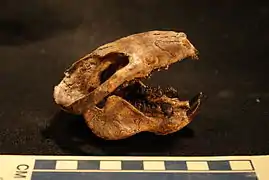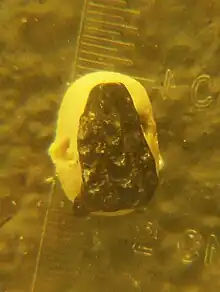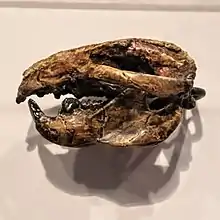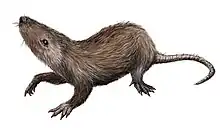Meniscoessus
Meniscoessus is a genus of extinct mammal from the Upper Cretaceous Period of what is now North America. It was a member of the extinct order Multituberculata, lying within the suborder Cimolodonta and family Cimolomyidae.
| Meniscoessus Temporal range: | |
|---|---|
 | |
| Meniscoessus skull in the Rocky Mountain Dinosaur Resource Center, Woodland Park, Colorado | |
| Scientific classification | |
| Domain: | Eukaryota |
| Kingdom: | Animalia |
| Phylum: | Chordata |
| Class: | Mammalia |
| Order: | †Multituberculata |
| Family: | †Cimolomyidae |
| Genus: | †Meniscoessus Cope, 1882 |
| Species | |
| |
Taxonomy

The genus Meniscoessus was named by Edward Drinker Cope in 1882. It has also been known under the following names: Cimolomys (partly); Dipriodon (Marsh 1889); Halodon (Marsh 1889); Oracodon (Marsh 1889); Moeniscoessus; Selenacodon (Marsh 1889) (partly); and Tripriodon (Marsh 1889).
The generic name has a complicated history. It is attributed to Cope, 1882. Later, this was joined by "Meniscoessus" (Marsh 1889). The second usage is apparently related to teeth described as belonging to small carnivorous dinosaurs. These were further christened Dipriodon, Tripriodon, and others, including Triprotodon. Close similarities were then noticed with an already established dinosaur genus, Paronychodon (Cope 1876), also based on teeth from the Laramie Formation. Over time, an impressive school of names was synonymized under P. However, this is now considered a nomen dubium.
In 1929, George Gaylord Simpson published American Mesozoic Mammalia (Mem. of the Peabody Museum, 3 pt. 1; i-xv). The name Tripriodon ("three saw tooth") was resurrected. These "theropod" teeth were actually mammalian. The mammal T. since seems to have fallen from use.
Meniscoessus is a valid multituberculate, known from high-quality fossils including many teeth.
Species
- Meniscoessus collomensis – Named by Jason A. Lillegraven in 1987. Fossil remains were found in the Upper Cretaceous strata of the Williams Fork Formation, in Colorado, USA. This species is known from only one site. It weighed an estimated 1.4 kilograms (3.1 lb).
- Meniscoessus conquistus – Named by Edward Drinker Cope in 1882. Remains were found in the Maastrichtian (Upper Cretaceous) strata of Colorado and of the St. Mary River Formation of Canada.
- Meniscoessus ferox – Named by Richard C. Fox in 1971. Remains were found in Campanian (Upper Cretaceous) strata of the Upper Milk River Formation of Alberta, Canada. The holotype, collected in 1968, is in the University of Alberta collection.
- Meniscoessus intermedius – Named by Richard C. Fox in 1976. Remains were found in the Campanian - Maastrichtian (Upper Cretaceous) strata of the Oldman Formation of Alberta and New Mexico, Utah, and Wyoming, USA. It is estimated to have weighed about 500 grams (18 oz), as much as a large rat.
- Meniscoessus major – Named by Loris Shano Russell in the 1930s. It is also known as Cimolomys major (Russell 1936). Remains were found in the Campanian (Upper Cretaceous) strata of Montana, USA, and Alberta. The weight of this species has been estimated at around 1 kilogram (2.2 lb). The holotype is in Alberta.

- Meniscoessus robustus – Named by Othniel Charles Marsh in 1889. Remains were discovered in Maastrichtian (Upper Cretaceous) and possibly Paleocene strata of Wyoming, Montana, and South Dakota, USA, and the St. Mary's River Formation of Canada. The weight of this species is estimated to have been about 3.3 kilograms (7.3 lb). Marsh authored a swamp of names. The first usage of M. robustus seems to go back to Osborn in 1891. It has also been known as Cimolomys sculptusy; Dipriodon lacunatus; D. lunatus (Marsh 1889); D. robustus (Marsh 1889); Halodon sculptus (Marsh 1889); M. borealis (Simpson 1927); M. coelatus; M. fragilis; M. greeni (Wilson R.W. 1987); M. lunatus; M. sculptus; Moeniscoessus robustus; Oracodon anceps (Marsh 1889); O. conulus (Marsh 1892); Selenacodon fragilis (Marsh 1889); and Tripriodon coelatus (Marsh 1889).
- Meniscoessus seminoensis – Named by Jaelyn J. Eberle and Jason A. Lillegraven in 1998. Remains were found in Campanian - Maastrichtian (Upper Cretaceous) strata of the Ferris Formation in Wyoming. A 3.5 centimetres (1.4 in) lower jaw was found near the Seminoe mountains. It has a close resemblance to M. robustus. It was somewhere between "rat-sized" and 3.5 kilograms (7.7 lb), depending upon which source. An alternative name for this location is "Leave No Toad Unturned."
Several other names have been in circulation, such as Meniscoessus bustus, Meniscoessus caperatus (Marsh 1889), and Meniscoessus coelatus. The first is probably a variant of M. robustus, while the latter two seem to have been connected with dinosaur teeth.
References
- Lillegraven (1987), Stratigraphy and evolutionary implications of a new species of Meniscoessus (Multituberculata, Mammalia) from the Upper Cretaceous Williams Fork Formation, Moffat County, Colorado. Dakoterra 3, p. 46-56.
- Cope (1882), "Mammalia in the Laramie formation." American Naturalist xvi, p. 830-831.
- Marsh (1889), "Discovery of Cretaceous Mammalia." Am. J. Sci. (3) xxxviii: 81–92.
- Osborn (1891), "A review of the Cretaceous Mammalia." Proc. Acad. Nat. Sci., Phila., p. 124-135.
- Simpson (1929), "American Mesozoic Mammalia." Mem. Peabody Mus. Nat. Hist. iii (i), p. 1-235.
- Wilson (1987), Late Cretaceous (Fox Hills) multituberculates from the Red Owl local fauna of western South Dakota. Dakoterra 3, p. 118-122.
- Kielan-Jaworowska Z & Hurum JH (2001), "Phylogeny and Systematics of multituberculate mammals." Paleontology 44, p. 389-429.
- Fox (1976), Cretaceous mammals (Meniscoessus intermedius, new species, and Alphadon sp.) from the lowermost Oldman Formation, Alberta. Canadian Journal of Earth Sciences, 13(9), p. 1216-1222, 4 figs.
- Fox (1971), "Early Campanian multituberculates (Mammalia: Allotheria) from the upper Milk River Formation, Alberta". Canadian Journal of Earth Sci. 8, p. 916-938.
- Much of this information has been derived from MESOZOIC MAMMALS: "basal" Cimolodonta, Cimolomyidae, Boffiidae and Kogaionidae, an Internet directory

